Digital Poster
Spine Imaging
ISMRM & ISMRT Annual Meeting & Exhibition • 10-15 May 2025 • Honolulu, Hawai'i

 |
Computer Number: 97
3120. Exploring
Lumbar Intervertebral Disc Degeneration via 23Na-MRI: A Clinical
Study

Y. Nakahashi, T. Saida, M. Yoshida, M. Shindo, K.
Yamada, T. Ishimori, M. Terakado, T. Ishiguro, J. Kwon,
T. Nakajima
University of Tsukuba Hospital, Tsukuba, Ibaraki, Japan
Impact: 23Na-MRI
offers a non-invasive method to quantitatively assess
intervertebral disc degeneration, complementing traditional
techniques. Its strong correlation with disc degeneration
indicators supports its clinical relevance, potentially
improving diagnosis and treatment for patients with chronic
low back pain.
|
|
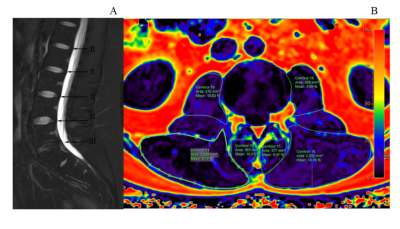 |
Computer Number: 98
3121. Quantitative
MRI Analysis of the Correlation Between Lumbar Paraspinal Muscle
Fat Content, Intervertebral Disc T2 Values, and Disc
Degeneration
C. XIA, W. Hou, Y. Tian, Y. Cheng, L. Han
Department of Radiology, Hefei, China
Impact: This study confirms that disc degeneration
significantly affects fat infiltration in paraspinal muscles
and holds important clinical value. Examining the
alterations in fat content in paraspinal muscles will
enhance our comprehension of the LBD resulting
from Intervertebral disc degeneration (IVDD).
|
|
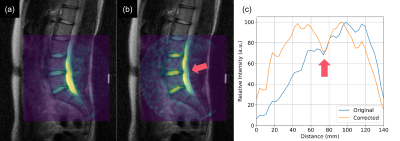 |
Computer Number: 99
3122. B1
field inhomogeneity correction of 23Na MRI for lumbar spine
J. Kwon, T. Saida, Y. Nakahashi, M. Shindo, K. Yamada, T.
Ishimori, Y. Katsumata, T. Yoshida, M. Yoneyama, T.
Nakajijma, M. Cauteren
Philips Japan, Tokyo, Japan
Impact:
In clinical environments where time and hardware are constrained, the proposed method would be useful for correcting the B1 field inhomogeneity for 23Na MRI. This technique can also be applied to wider regions and patient populations. |
|
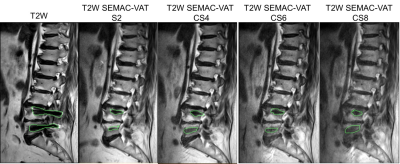 |
Computer Number: 100
3123. Evaluating
the Value of SEMAC-VAT with Compressed SENSE Technology in MRI
Metal Artifact Reduction in Patients with Lumbar Metal Implants
H. Cao, D. Zheng, D. Zhao
Beijing Chaoyang Hospital, Capital Medical University,, Beijing, China
Impact: SEMAC-VAT technology integrated with Compressed
SENSE provides a promising solution for metal artifact
reduction in patients with lumbar metal implants within
clinical acceptable time.
|
|
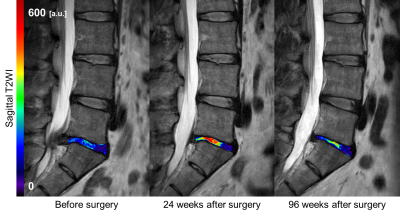 |
Computer Number: 101
3124. Can
Texture Features of T2WI Capture the Effectiveness of Gel
Implantation Treatment for Intervertebral Disc Degeneration?
M. Kitagawa, M. Saito, K. Yamada, H. Sudo, K. Tha
Department of Biomarker Imaging Science, Graduate School of Biomedical Science and Engineering, Hokkaido University, Sapporo, Japan
Impact: Our results indicate that IVD degeneration may
be inhibited and IVD tissue is preserved in the gel group.
Texture features, which provide information on the spatial
distribution of pixels, could evaluate the efficacy of new
treatments for IVD degeneration.
|
|
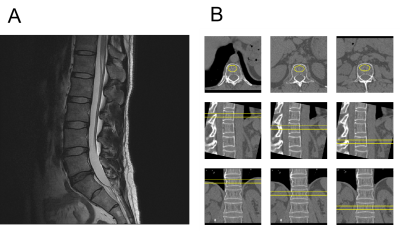 |
Computer Number: 102
3125. Lumbar
disc degeneration is significant correlated with lumbar
spine volumetric BMD in male patients with NSLBP, except for the
L5/S1 disc
X. Xiang, Y. Zhang, Z. Li, H. Liang, J. Chen
Chengdu Sport University, Chengdu, China
Impact: L1/2-L4/5 disc being an independent influencing
factor of vBMD in male NSLBP patients. Further investigation
can explore if the degree of L1/2-L4/5 intervertebral disc
degeneration through MRI can predict OP, thereby reducing
the occurrence of complications such as osteoporotic
fractures.
|
|
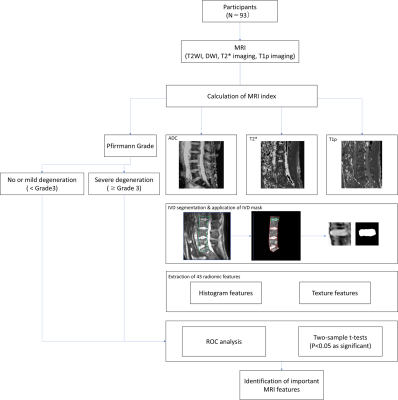 |
Computer Number: 103
3126. Identification
of significant quantitative MRI features for lumbar
intervertebral disc degeneration through comprehensive image
analysis
M. Saito, M. Kitagawa, D. Sakamoto, K. Yamada, H. Sudo, K.
Tha
Hokkaido University Graduate School of Biomedical Science and Engineering, Sapporo, Japan
Impact: This study highlights that incorporating texture
features of quantitative MRI indices (ADC, T2*, and T1ρ) can
improve determination of the severity of IVD degeneration.
|
|
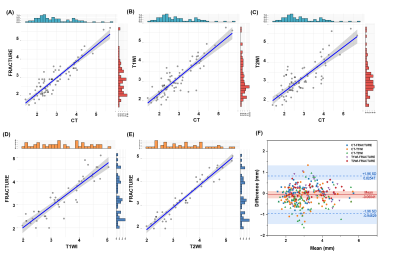 |
Computer Number: 104
3127. Differentiation
of Osteophytes and Disc Herniations Using FRACTURE MRI sequence
in Patients with Cervical Radiculopathy
D. Jiang, J. Hong, D. She, D. Cao, S. Lei, X. Zhao
First Affiliated Hospital of Fujian Medical University, Fuzhou, China
Impact: FRACTURE is a reliable technique for
differentiating osteophytes and disc herniations. This could
be relevant for younger patients in order to prevent
unnecessary radiation exposure and may also facilitate a
one-stop-shop approach and speed up diagnostic work-up.
|
|
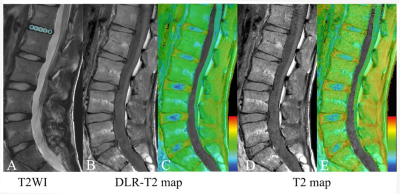 |
Computer Number: 105
3128. Deep
learning-based reconstruction and conventional T2 map in
quantitative detection of lumbar intervertebral disk
degeneration
F. Zeng, Y. Zha, W. Liu, Y. Fan
Renmin Hospital of Wuhan University, Wuhan, China
Impact: DLR-T2 might provide superior information on the
biomechanical properties of early IDD, which would be
helpful in prognoses and in improving therapy strategies.
|
|
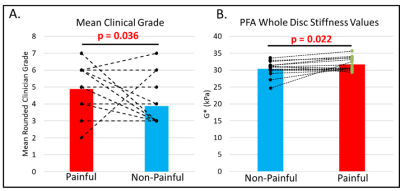 |
Computer Number: 106
3129. MRE-Derived
Stiffness Measurements of Painful and Non-Painful Discs from Low
Back Pain Patients
Z. Osborn-King, M. Co, T. Weaver, N. Hussain, B. Raterman,
A. Kolipaka, B. Walter
The Ohio State University College of Engineering, Columbus, United States
Impact: Developing a method to objectively measure
tissue stiffness, demonstrating there are mechanical
differences in painful discs compared to non-painful
controls, and demonstrating compositional differences
between these groups allows clinicians and researchers to
have more tools to assess low back pain
|
|
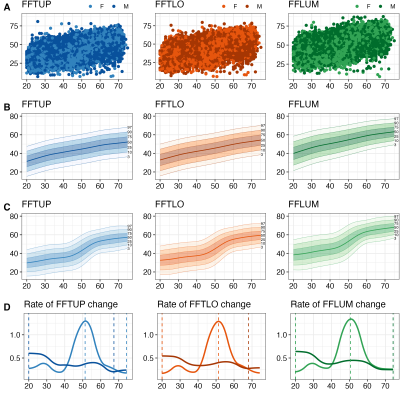 |
Computer Number: 107
3130. The
aging spine: Data from the German National Cohort (NAKO)
M. Löffler, M. Jung, M. Reisert, H. Schön, J. Kirschke, S.
Rospleszcz, C. Schlett, F. Bamberg, V. Raghu, J. Weiss
University Medical Center Freiburg, Freiburg, Germany
Impact: We showed how WFI can depict physiologic changes
in BMFF and IVD water content with age. Widespread use of
clinical WFI combined with fully-automated image analysis
could help detect individuals with increased fracture or
cardiovascular risk due to high BMFF.
|
|
 |
Computer Number: 108
3131. Added
Value of 3D Fast-field-echo (FRACTURE) Sequences for Cervical
Spondylosis Diagnosis: A Prospective Multi-Reader
Non-Inferiority Study
Q. Wang, N. Lang, X. Xing, S. He, Y. Yang
Peking University Third Hospital, Beijing, China
Impact: The FRACTURE protocol demonstrated comparable
performance to CT in assessing bone abnormalities in
cervical spondylosis, offering the potential to reduce
radiation exposure and streamline the diagnostic process for
patients.
|
|
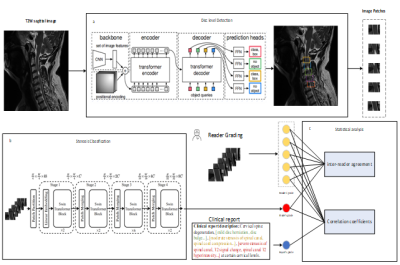 |
Computer Number: 109
3132. Feasibility
of Fully Automatic Assessment of Cervical Canal Stenosis at MRI
Using Deep Learning
Y. ZHANG, X. Feng, P. Yang, Y. Luo, K. Cao, Y. lv, H. Xu
Shanghai Fourth People's Hospital, Shanghai, China
Impact: The deep learning (DL) model could fully
automatic and reliably assess cervical canal stenosis at MRI
and provide a stable and objective cervical spine MRI
diagnostic tool, thereby reducing doctors’ labor.
|
|
 |
Computer Number: 110
3133. Exploring
Risk Factors for Chronic Low Back Pain in Young Patients: A
Study Using Synthetic MRI and Proton Density Fat Fraction
Analysis
F. Zou, S. Zhong, J. Zhang, R. Guo
The Third Affiliated Hospital of Sun Yat-sen University, Guangzhou, China
Impact: This research presented the significance of
using synthetic MRI (SyMRI) and proton density fat fraction
(PDFF) sequences to evaluate muscle health. Targeted
rehabilitation to reduce fat infiltration in paravertebral
muscles could enhance CLBP management and improve patient
outcomes.
|
|
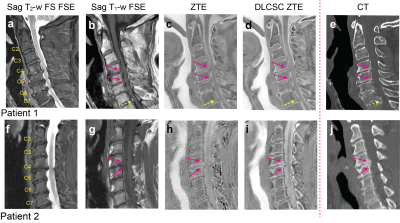 |
Computer Number: 111
3134. Deep
Learning-Based Chemical Shift Artifact-Corrected Zero-Echo Time
MRI for the Cervical Spine
M. Han, P. Wang, C. Wang, J. Baal, S. Mandava, M. Fung, S.
Majumdar, V. Shah, C. Chin
University of California, San Francisco, San Francisco, United States
Impact: Deep learning-based chemical shift
artifact-correction reconstruction can greatly improve SNR
and reduce chemical shift artifacts for ZTE imaging, and
allow for bone visualization close to CT. ZTE can be a
radiation-free alternative to CT.
|
|
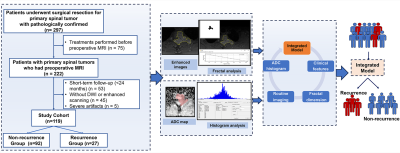 |
Computer Number: 112
3135. Feasibility
of ADC Histogram Analysis for Predicting of Postoperative
Recurrence in Aggressive Spinal Tumors
Q. Wang, N. Lang, X. Ji
Peking University Third Hospital, Beijing, China
Impact: Future individualized follow-up protocols may
benefit from incorporating the ADC histogram prediction
model, allowing for better selection of patients with
aggressive primary spinal tumors for appropriate clinical
interventions.
|
The International Society for Magnetic Resonance in Medicine is accredited by the Accreditation Council for Continuing Medical Education to provide continuing medical education for physicians.